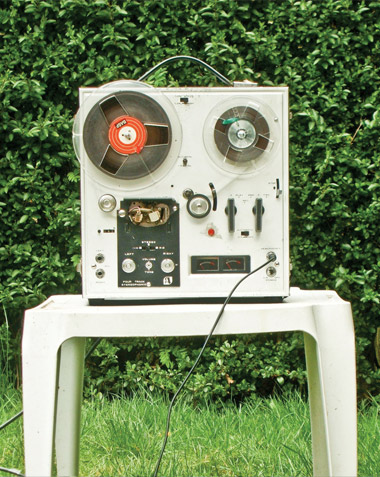

As a continuation/mutation on the scissors theme, I decided
before making any compositional processes that I would use 1/4" reel
to reel tape and a razor blade as a fundamental medium. I had
a few audio files from Pierre which were short but had a common
key, so I realised a good place to start would be to create tape
loops using Pierre's samples, a razor blade, a splicing block,
a chinagraph pencil and some splicing tape. My main machine for
playing the tape loops was an Akai valve reel to reel recorder.

I have a reel of tape in my collection which has passed its
sell by date by a long shot, the magnetic oxide flakes off
with very little friction. The idea of using tape loops which
physically deteriorate is obviously associated with William
Basinski and his 'Disintegration Loops'. I didn't want to
avoid this fascinating process for the sake of avoiding any
artistic mimicry, so I thought of other ways to incorporate
the ideas of decay into my piece.
I reversed Pierre's samples before transferring them to tape, so when a tape loop was
formed, the audio would be reversed and then as the loop
played and the result recorded back into the computer, the
loop would crumble and decay. Then when several minutes of
decaying audio was recorded onto the computer, I would then
reverse the whole recording to render Pierre's sample 'forwards'
again, but now the decaying or 'disintegration' process has been
reversed.
There are two main loops in the piece which use this
method, both are made of Pierre's samples. They start off as
sparse, broken and crumbled fragments and then eventually build
and replenish to become more complete and recognizable, the process
is very organic sounding. The tape loops then became the backbone
of the piece, they determined the key and mood, the meter is
loose and vague however. 
My next step was to continue with the
decay theme but this time using my favourite vintage digital
delay pedal. The pedal allows a 4 second delay which can be set
to decay over a fairly long period of time. I used the pedal
in this piece to create a continuous electric guitar improvisation.
Using the tape loops of Pierre's samples as a 'drone' to follow,
I improvised sparsely, building up more intricate cyclic patterns
note by note. As the pedal loops, notes crumble and fade into
the distance, and new notes are constantly being added, so the
building and the decaying is a seamless process which is complemented
by the reversed decaying of the tape loops.
Other sound sources in the piece include a small Romanian melody
harp and location recordings. The guitar improvisation was also captured
to reel to reel tape, and then played back out of the internal speakers
of the Akai machine and captured both directly from a line out and with
a microphone. To get away from the confines of my studio and to exploit
the drama of spring, I took various machines into my garden to recapture
the recorded improvisation in a real environment. My set up was surrounded
by hedges where birds and insects go about their daily lives, contributing
to cycles of birth and decay.

Stephen Wilkinson/ May 2009

|





